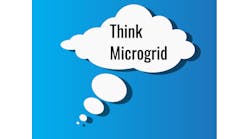In this new special report series, we explore the potential of microgrids in hospitals to prevent outages and downtime. Here we discuss microgrid business models that make it easier for healthcare facilities to move forward with projects.
Get the full report.
The growth of microgrids in recent years has brought with it advances in business models that make microgrids more financially feasible for a variety of organizations and institutions, including hospitals.
From an operational perspective, there are many types of microgrids. The two major categories are off-grid and on-grid. An on-grid microgrid is connected to the surrounding electric power grid but has the ability to island when needed. On-grid microgrids are often created for their resilience value or to improve reliability. They can be used in settings that are as small as a single facility, such as a home, commercial building or hospital, or they can be deployed in campuses designed for universities, healthcare centers, research parks and military bases.
Just as the setting and function of a microgrid can vary, there are a variety of business models available to organizations that want to install a microgrid.
Off-grid microgrids, those not connected to a central grid, tend to be found in remote areas, such as Silvies Valley Ranch, an eco-friendly community in Burns, Ore., or Cuttyhunk Island in Massachusetts. Just as the setting and function of a microgrid can vary, there are a variety of business models available to organizations that want to install a microgrid. Those business models have evolved as the microgrid market has expanded.
The most basic model is also the simplest: the customer-owned microgrid. A customer, such as a hospital, pays a developer to install a microgrid. Usually these agreements are structured as a turnkey contract that covers a developer’s costs — construction, financing (interest payments) and equipment. In this model, the customer takes on the financial risk in terms of project completion and the performance of the microgrid once it is in place and operational. The parties can modify the agreement to defer, offset or share aspects of project risk, such as completion or performance guarantees.
Organizations looking for more flexibility and less risk can now take advantage of an alternative model, the microgrid-as-a-service model. From a client’s perspective, the main benefit of the microgrid-as-a-service model is that it eliminates the upfront cost of installing a microgrid. This can be a very attractive benefit for businesses, such as hospitals, that have a need for high reliability but are under pressure from rising costs and shrinking margins.
In addition, many businesses are reluctant to take on the risk of building a microgrid because they are wary of becoming involved in a business that is not central to their core mission.
The as-a-service model simplifies the installation of a microgrid by distancing the organization or client from the development and construction process, as well as from operation and maintenance costs. The organization’s responsibility is distilled to making a series of payments over time. This avoids having to monitor operation and maintenance costs, and it can be helpful for financial planning. The as-a-service model provides the certainty of regular, predictable payments, instead of fluctuating payments to a utility and the possibility of rate changes.
The model has several variants. Some contracts are structured as power purchase agreements, others as leases, or some as pay-as-you-go arrangements. The underlying concept is the same for all of the models. A developer takes on the financial risk of funding and building a microgrid for a client and, upon completion, operates the microgrid for the customer. The client pays the developer for the microgrid through a series of contractual payments. Payments are made for an agreed-upon amount for energy consumed over a set time frame. The payments can vary from a simple repeating fixed amount to energy prices that include both volumetric and capacity components. Payments can also be linked to an index, such as wholesale power market prices, or to the price of another commodity, such as the cost of natural gas, which is often used for microgrids that feature a fuel cell or some form of gas turbine.
Separate but related to the power purchase model is the lease model in which a developer installs a microgrid for a client, retains ownership of the facility and leases it to the microgrid host, who makes monthly lease payments and also often receives the right to acquire the microgrid at the end of the lease term.
Leasing structures are particularly popular when a microgrid is eligible for a tax credit. A microgrid with solar panels or battery storage could be eligible for a federal investment tax credit, for instance, but not-for-profits and some other entities cannot use those credits. A lease allows the developer to use the tax credits, which can help reduce overall costs of the project.
Another variation of the as-a-service model is the pay-as-you-go model, in which payments are only made as the client uses the energy produced by the microgrid. It has become a popular model in the developing world.
When experienced third parties operate microgrids — the approach used in as-a- service models — they can enhance the microgrid’s revenue potential, which can lower costs for the microgrid host. Microgrid developers are adept, in a way that many microgrid hosts are not, in undertaking “value stacking,” the practice of layering revenue streams from a facility, such as a microgrid.
If a hospital enters into a microgrid-as-a-service agreement, the microgrid can be available to the host for backup power. When the host does not need the output of the microgrid, the owner can run the microgrid remotely, turning it on when grid power prices spike in order to save the host money or selling power to the grid in the form of ancillary services, such as capacity or demand response, that can generate income. By monitoring market conditions, the microgrid owner is able to schedule the microgrid to run when conditions warrant. By using value stacking to increase microgrid revenues, the overall cost of a project can be reduced for the owner with savings passed on to the host, making microgrids an affordable solution for hospitals.
Catch up on the first entry in the series here, that outlines a recent turning point for healthcare microgrids. The second highlighted healthcare microgrid types growing as options for critical facilities to avoid outages. Next up was an exploration of how microgrids in hospitals can bolster public health efforts. Lastly, we will explore hospital deployments and a series of healthcare microgrid case studies.
Download the full report, “Microgrids for Hospitals and Healthcare,” free of charge courtesy of Bloom Energy.







